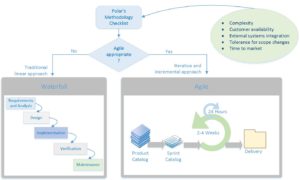Software lifecycle models are designed to achieve various objectives. We use both traditional waterfall methodology and agile methodologies.
We Do Scrum of Scrums (SoS)
Polar’s Agile
Polar adopted all 12 principles of Agile. Polar’s agile development processes are incremental and iterative software development by teams working in close collaboration. Our methodology powers us to rapidly build out complex applications, efficiently handle changing requirements, and improve the overall product quality through a rigorous QA process.
Features
- Dollar value is determined up front for a story point
- A forecast is agreed to in terms of ballpark story points for overall contract duration and at key milestones, such as upcoming releases
- Clearly documented definition of “Done” at the release and at the sprint entry and exit levels for user stories
- Our teams can operate any way necessary to fit together with the customer’s available skill set
Polar also offers one level above Agile, i.e. Scrum of Scrums (SoS), an important technique forscaling Scrum to large project teams for achieving business objectives. SoS consists of clusters of teams working in a distributed environment.
Our U.S.-based and India-basedteams are very experienced at facilitating collaboration among groups of developers and customer stakeholders.
Polar’s process on waterfall methodology
The waterfall model of software lifecycle specifies a strict sequence of iterations for development activity, with precise goals for each development phase. We use the waterfall model for testing small projects where requirements are simple and well-defined. Due to cascading effects from one phase to the next, this method is cost effective, easy to use andto follow, and allows managerial control and departmentalization.
Polar defined a checklist that determines the appropriate methodology for each of our projects. We collaborate with clients to define requirements and translate them into user stories.



